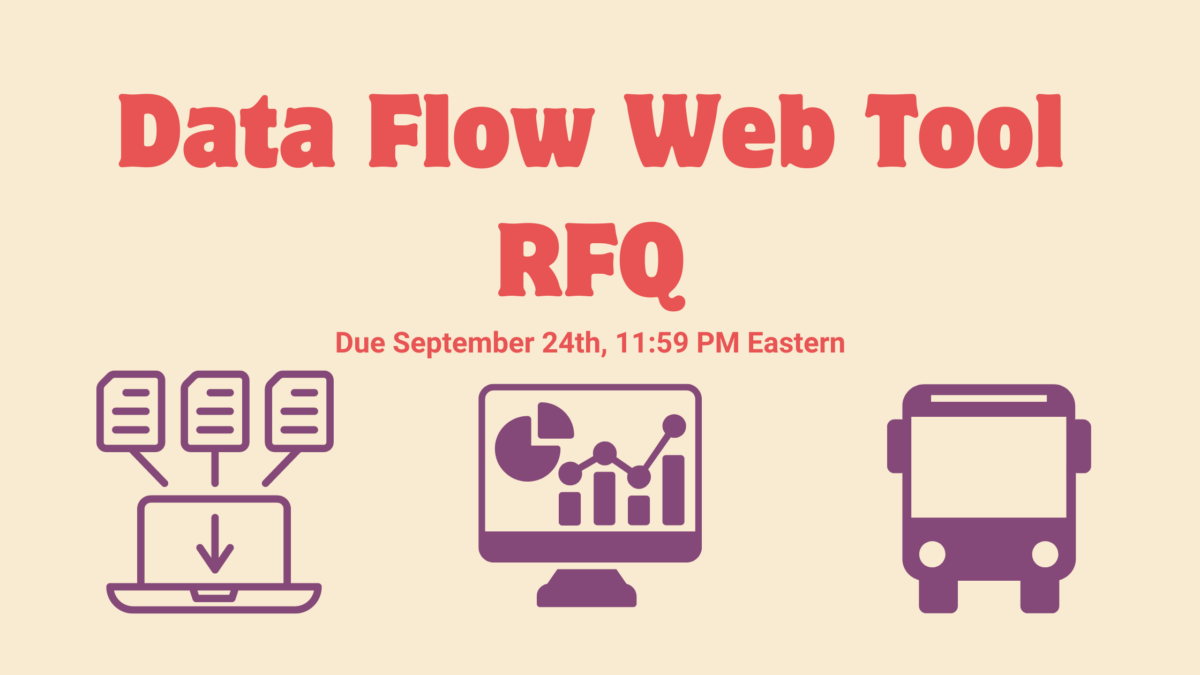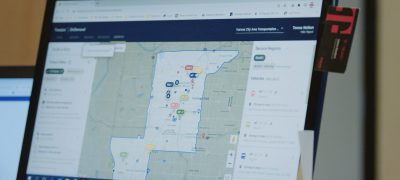
The Community Transportation Association of America (CTAA) is soliciting bids from consultants in support of the Federal Transit Administration-funded National Center for Applied Transit Technology (N-CATT) in supporting staff to develop and administer a web-tool that transit agencies can use to map out how their agency collects and manages data, in order to identify pain points and plan improvements to their processes.
The selected consultant(s) will work closely with N-CATT staff on this project.
Interested consultants should read the attached RFQ and submit quotes in the format outlined under Bid Requirements.
This opportunity is open to all:
- Who are able to receive federal funding and are not excluded or affiliated with an excluded organization from receiving federal dollars;
- American organizations ( E.O. 14005 Made in all America, by all of American’s workers);
- Small and minority business; women owned small business and labor surplus firms.
Any questions should be sent to carpenter@ctaa.org, and they will be answered on this webpage.
Please submit your bid as one PDF document to Andrew Carpenter at carpenter@ctaa.org by 11:59pm Eastern on September 24, 2024.
Q&A
- What is the technical expertise of the target audience? Should the tool be designed for users with limited technical knowledge, or will it be geared toward more advanced users?
A: The tool should be built with the assumption that users will have limited technical expertise, and limited capacity at the individual and staff levels to engage in significant overhauls of their data infrastructure. - Are there specific use cases or data types (e.g., CAD/AVL, route planning) that the tool should prioritize?
A: The original idea of this tool is to provide an overview of data flows across the agency, at least regarding operations. We are open to suggestions if vendors make a good case for focusing on specific operational aspects. - What data sources or systems are expected to be integrated into the tool (e.g., CAD/AVL, scheduling software)? Should the tool be flexible to incorporate a wide range of technologies? Will agencies have access to real-time data or historical data?
A: This won’t be integrated with other systems; it’s just for managers to understand how the components of their agencies provide/fail to provide data and to communicate that data across systems. - a) How should the tool to identify and highlight pain points in the data flow? Should it include automatic detection of inefficiencies, or will it rely on user input? b) Should the tool provide specific recommendations for resolving identified data flow challenges, and if so, what level of detail is expected in those recommendations? c) Is there a preferred technology stack or platform that should be used to develop this web-based tool (e.g., cloud-hosted, open-source technologies)? d) Will the tool allow users to customize data flow diagrams to fit their unique system structures, and should it include predefined templates for common transit data systems? e) Should the tool support mobile devices, or will it primarily be used on desktop browsers? f) Should the tool be exportable to various formats, including printing?
A: Vendors should indicate how they plan to achieve the goals of this project. - Will the tool need to be customized for different transit agencies, or will there be a one-size-fits-all solution that smaller agencies can adapt to their needs?
A: The tool should be interactive, for agencies to build their own diagrams. - Will N-CATT require training materials or sessions for transit agency managers and staff to effectively use the tool?
A: The tool should be built so that individuals can use it without training; CTAA should be able to help agencies interpret or use the tool. - a) What level of ongoing support is expected for the tool, both for technical maintenance and user assistance? b) Should the tool be designed with scalability in mind, allowing for future expansion to incorporate new data sources or additional functionality?
A: CTAA will be responsible for ongoing maintenance and user assistance. It should be easy for CTAA to modify later in case other criteria or inputs are identified. - What is the expected timeline of the project?
A: As stated in the RFQ, all work needs to be completed by 3/31/25. Timelines for tasks within the period of performance will be negotiated between the vendor and CTAA. - What is the budget for this project?
A: As stated in the RFQ, vendors should indicate the price for which they are prepared to do this work - Under section 3 Staffing Plan, does the one-page resume count toward the point “a” which has 3 pages limit?
A: The RFQ states that there is a 2-page limit for the staffing narrative plus 1-page resume per staff participant. - Do vendors have to provide the pricing twice, one in point 1 Cover Sheet, and one in point 4?
A: Yes. - Can vendors provide commercial experience as work samples?
A: Work samples should highlight consultants’ ability to perform the work in this RFQ. N-CATT prefers samples that are similar in type or topic to that described in this RFQ. The samples must reflect the work of the individuals in the staffing plan so that CTAA can directly gauge consultants’ work quality. - Can vendors meet the DBE requirement through a subcontractor?
A: Yes, if the DBE performs at least 50% of the hours on the project. - Are vendors required to provide references?
A: References are not required. - If the vendor utilizes a subcontract is it mandatory for the subcontractor to be registered and include their Unique Entity ID (UEI) number in the proposal response?
A: All subcontractors must meet the same requirements as primary contractors. - Is there a specific agency, entity, or location where DBE certification is required?
A: The bid should provide proof of DBE certification. - Is it mandatory to provide proof of good standing with the FTA or any other agency? If so, does this requirement also apply to subcontractors?
A: Vendors should provide statements to their authority to work and that they are not debarred. All subcontractors must meet the same requirements as primary contractors. - Are vendors required to provide the subcontractor information within the staffing plan? if yes, is the page limit 3 pages for the prime and 3 pages for the subcontractor?
A: Please only provide one staff narrative for the primary and subcontractors. There is a 2-page limit for the staff narrative. - Do vendors have to include resumes for the subcontractor’s team members in the Staffing Plan?
A: All subcontractors must meet the same requirements as primary contractors. - Will there be an extension for the due date submission?
A: CTAA does not anticipate extending the submission date at this time. - Does CTAA accept offshore resources to execute the project?
A: No. - Can the vendor change personnel from those proposed in the vendor response?
A: CTAA expects to work with the personnel in the proposal, which is why we request information on the staff. - What are the pain points CTAA hopes to highlight in the tool? Should the tool provide specific recommendations?
A: The purpose of the tool is to help individual agencies identify their pain points by visualizing how their data sources connect across the agency’s various systems. If the vendor can build something that points out issues or can generate recommendations, we encourage vendors to include that in their response.
- Is there an existing contract for this work?
A: No, this is a new project. - Can vendors submit modified bids if they are providing confidential information?
A: We don’t anticipate any information requested to be confidential, but redactions or modifications should not interfere with understanding the proposal. - Can vendors provide digital signatures?
A: Yes

